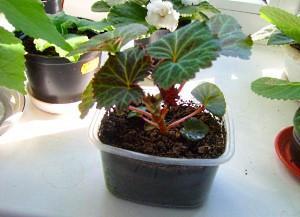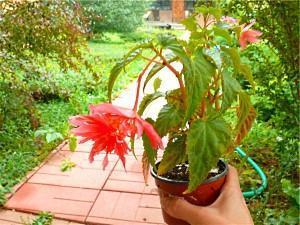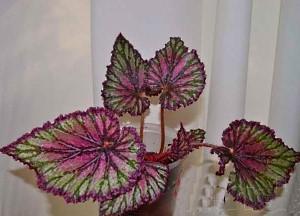Propagation of begonias by stem cuttings
 Plant lovers are well aware of the situation when a flower they like is either not on sale or it is too expensive. This happens especially often with begonias, since they have so many varieties and varieties. Therefore, the owners of these beauties have a need to quickly get a young copy.
Plant lovers are well aware of the situation when a flower they like is either not on sale or it is too expensive. This happens especially often with begonias, since they have so many varieties and varieties. Therefore, the owners of these beauties have a need to quickly get a young copy.
Breeding methods for begonias
Depending on the species, begonias can be propagated:
- seeds (all flowering species);
- dividing tubers (tuberous species);
- leafy cuttings and leaf parts;
- stem cuttings (any begonias that have a stem).
Seed propagation is the longest and most unreliable method. It is suitable when there is no material for vegetative propagation or when a large number of plants are needed. Due to the characteristics of the plant, the process of sowing and germination is quite complicated.
Vegetative reproduction guarantees the preservation of all the characteristics of the mother specimen.
When using leaf cuttings of begonia or parts of its leaf, babies are formed that develop as slowly as sown ones.
Benefits of stem cuttings begonia
Cutting begonias in parts of the stem is preferable to other breeding methods because this option:
- the fastest,
- the most reliable,
- allows you to keep the characteristics of the variety
- simple,
- suitable for almost all types of begonias.

Reproduction of begonias by stem cuttings, due to obtaining copies identical to the parent, allows you to preserve the gene pool of especially valuable varieties and varieties.
Subject to the technology, the method of begonia cuttings does not cause trouble for the grower.
Almost any begonia is easy to propagate by stem cuttings. Even in royal begonias, propagation by cuttings is possible if the top of old specimens is cut off, which has not yet had time to become a rhizome.
Begonia propagation technology by stem cuttings
Cutting begonia includes the following stages:
- cutting and preparation of cuttings,
- drying of sections,
- rooting,
- planting rooted stems.
 For cuttings, pieces of healthy stems 8-12 cm long are used. Cuttings can be apical (taken from the tip of the plant stem) and median. In any case, at least two or three buds should remain on them. Excess leaves are removed so that they do not take away the strength from the sprout. It is enough to leave 1-2 leaves. After that, you need to dry the slices slightly.
For cuttings, pieces of healthy stems 8-12 cm long are used. Cuttings can be apical (taken from the tip of the plant stem) and median. In any case, at least two or three buds should remain on them. Excess leaves are removed so that they do not take away the strength from the sprout. It is enough to leave 1-2 leaves. After that, you need to dry the slices slightly.

There are two ways to root begonia cuttings: in water and in a substrate.
In the first case, the lower part of the prepared begonia cuttings is placed in a vessel with soft water at room temperature. Do not use hard or cold water. The vessel is placed in a moderately warm (18-20 degrees), light, but not in direct sun place. After that, it remains to be patient and observe ... If the container is transparent, then the state of the cut will be clearly visible. Thus, the grower will not miss the moment of the appearance of the first roots and the time of planting. In addition, you can notice in time if the cut of the cutting has begun to rot.Then they take it out of the water, cut off the spoiled place, dry it again and place it in fresh water. After the appearance of roots 1-2 cm in size, the cutting is planted in a suitable soil and then acts as after a conventional transplant.

You can also root cuttings of begonias in a substrate, which can be used as wet peat, sand or soil suitable for begonias. In this case, the cut of the prepared cutting is dipped in water, and then in a special preparation that facilitates the formation of roots (root, heteroauxin, or some other).
In a small pot (in accordance with the size of the cutting), a suitable moist substrate is poured onto the drain. The stalk should be stuck into the ground, deepening the cut by 1-2 cm.
After that, the pot is tightly covered with a transparent jar or placed in a tight-fitting transparent container that is suitable in size. No part of the plant should touch the walls or the roof of the greenhouse.

After a while, perspiration will appear on the sides of the container. This indicates the formation of a suitable microclimate. Further - every day for a minute you need to open the greenhouse for airing and observe. As soon as new leaves appear, the greenhouse is removed. The new plant is ready.
You can use any of the methods described. It is more convenient to observe the process of root formation in water. This method is more familiar. But the roots are fragile, and when planted, they are usually injured. And the plant has to adapt to new habitat conditions. The process of engraftment and growth slows down, begonia weakens.
When rooting in the ground, the roots are immediately adapted to extract moisture and nutrition from it. As a result, the plant obtained in this way outperforms its "water" counterparts in growth.